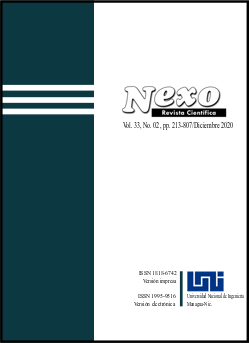Investigación del efecto de los cambios en el uso de la tierra en la erosión del suelo utilizando técnicas basadas en RS-GIS y AHP-Fuzzy (Estudio de caso: Qaresu Watersu, Ardabil, Irán)
DOI:
https://doi.org/10.5377/nexo.v33i02.10789Palabras clave:
lógica difusa, uso del suelo, probabilidad máxima, erosión hídrica, combinación lineal ponderadaResumen
La intensidad de la erosión del suelo que se producirá en una región depende de múltiples factores, incluidas las condiciones climáticas, la elevación, el terreno, el tipo de suelo y el uso del suelo. Entre estos factores, el uso de la tierra es uno de particular importancia, ya que refleja el enorme papel de los seres humanos en la exacerbación de la condición de erosión. Este estudio tuvo como objetivo investigar los efectos de los cambios de uso de la tierra en la erosión del suelo en la cuenca hidrográfica de Qaresu, utilizando técnicas de Teledetección (RS) y Sistema de Información Geográfica (GIS), una cuenca hidrográfica con un área de 4370,8 km2 ubicada en el centro de la provincia de Ardabil, noroeste de Irán. Para este propósito, las imágenes Landsat de 1985 y 2015 capturadas por los sensores TM y OLI-TIRS se utilizaron para desarrollar los mapas de uso del suelo del área de la cuenca utilizando el método de máxima verosimilitud. Los mapas de zonificación de erosión se desarrollaron integrando los mapas de uso de la tierra, pendiente, litología, distancia de las carreteras, distancia de los arroyos, precipitación y suelo utilizando el método de combinación lineal ponderada (WLC) después de una etapa de ponderación basada en AHP. Los resultados mostraron que en el período de 30 años de 1985 a 2015, la región ha experimentado una disminución en el área de bosques, cultivos de secano y pastizales y un aumento en el área de usos de la tierra definidos como urbanos, estériles, irrigados. agricultura y cobertura de agua. En total, la agricultura de secano y los pastizales fueron los usos más importantes de la tierra en el área estudiada. De acuerdo con los mapas de zonificación de erosión desarrollados, en 1985, 14,4% y 36,84%, y en 2015, 15,64% y 32,3% del área estudiada pertenecía a zonas de alto y muy alto riesgo en términos de potencial erosivo, respectivamente. En dos períodos definidos, las zonas de alto riesgo y muy alto riesgo se ubicaron principalmente sobre tierras agrícolas secas y de regadío.
Descargas
Descargas
Publicado
Cómo citar
Número
Sección
Licencia
Derechos de autor 2021 Universidad Nacional de Ingeniería

Esta obra está bajo una licencia internacional Creative Commons Atribución 4.0.
Los autores que publican en Nexo Revista Científica están de acuerdo con los siguientes términos:
- Los autores conservan los derechos de autor y conceden a la revista el derecho de la primera publicación bajo la licencia Creative Commons Attribution License https://creativecommons.org/licenses/by/3.0/, que permite a otros compartir el trabajo con un reconocimiento a la autoría de la obra y a la publicación inicial en Nexo Revista Científica.
- Los autores pueden establecer por separado acuerdos adicionales para la distribución no exclusiva de la versión de la obra publicada en la revista (por ejemplo, en un repositorio institucional o en un libro) con el reconocimiento de su publicación inicial en Nexo Revista Científica.
- Se permite y se anima a los autores a difundir sus trabajos electrónicamente (por ejemplo, en repositorios institucionales o en su propio sitio web) antes y durante el proceso de envío, ya que puede dar lugar a intercambios productivos, así como a una citación más temprana y mayor de los trabajos publicados.











